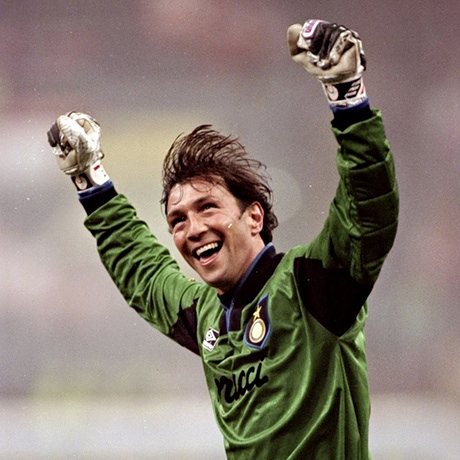Walter Zenga kept goal for Italy and Internazionale for the best part of a decade. Nicknamed L’Uomo Ragno (Spiderman), Zenga’s incredible agility allowed him to make remarkable reaction saves that were as aesthetically pleasing as they were important.
The club’s youth academy was originally responsible for unearthing this rough diamond although they eventually let him go. He roamed the lower leagues of Italian football in search of a contract, starting out at Salernitana before moving to Savona and eventually Sambenedettese.
In 1982 he returned to Internazionale and started to push for a first team spot, eventually taking the No1 jersey in 1983. This was the start of the glory years for Zenga as his ability to allay consistency with moments of sheer brilliance started to make the rest of Serie A sit up and notice.
Zenga’s positional ability was as important as his agility. He could stop shots, catch crosses and make show-stopping saves. Not only would he have a great starting position but anything that was fired quickly to either side of him was normally dealt with comfortably. When he conceded it was usually a very good goal indeed.
The Nerazzurri faithful were treated to 11 years of Zenga’s fine form, gymnastic ability and dramatic cursing at defenders and the skies when something went wrong. The most successful of his 328 appearances came in the 1988-89 season when Internazionale lifted the Scudetto. With players such as Andreas Brehme, Lothar Matthäus and Ramón Díaz, Internazionale under Giovanni Trapattoni were superb that season.
They could not retain the title the following season but Zenga did pick up an Italian Super Cup. The club acquired Jürgen Klinsmann and with the squad looking strong it was a surprise that Zenga never managed to add another Scudettowhile playing for the Nerazzurri.
Even so, these were the keeper’s best years as he displayed breathtaking performances for both club and country. The awards followed suit as Zenga wasIFFHS World’s Best Goalkeeper for three years running in 1989, 1990 and 1991 and was also given the award for Uefa Goalkeeper of the Year in 1990. He went on to win a Uefa Cup with Internazionale in 1991. He moved to Sampdoria in 1994 and, after two seasons with the Blucerchiati he left for Padova, before finally moving to the US in 1997.
Zenga was one of the stars of the Italia 90 World Cup. After playing in Italy’s 1984 Olympic team and the 1988 European Championship team in Germany he was no stranger to the national team. His performances for his club meant that, when the World Cup came to home soil, he was without question the No1. This was his showpiece as Italy went on to claim third spot and Zenga set a record of not conceding a goal at the finals for 518 minutes, keeping five clean sheets in a row. His countless saves propelled Italy to the semi-finals where he was beaten only once by a Claudio Caniggia header – unfortunately this was his only lack of concentration in the tournament as he was beaten in the air by the Argentinian when coming to punch. A defeat on penalties followed, but he had performed admirably throughout the competition.
Zenga’s expert mind for the game and physical ability put him up there alongside Dino Zoff and Gigi Buffon as one of Italy’s great goalkeepers. Italy has a tradition of producing great goalkeepers but to do this you sometimes need to break the mould. They certainly did with Walter Zenga.

